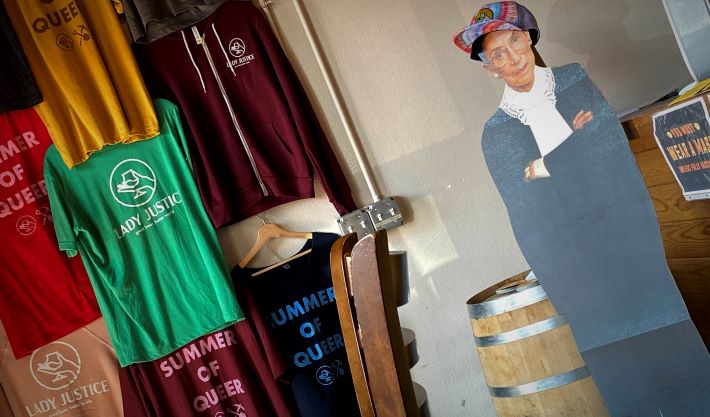
The headlines Feedly delivered were more than enough
– We Drank And Ranked 23 Beers From Elysian Brewing To Find The Best One
– The Difference Between White Claw and Truly, Explained
– This Is the Worst Cheap Beer in America
– White Zinfandel, the Acid-Washed Jeans of Wine
– Robot Waiters Have Descended on Silicon Valley
– 8 Things You Should Know About Twisted Tea
– Much Adew About . . . Something – Boston Beer, Pepsico HRD MTN DEW Deal Portends Fuzzing Categories at All Tiers
Jeff Alworth did read the last post on my list, which becomes part of his own. And one takeaway for me personally from “Maybe We Don’t Need to Shout at Jim Koch’s Latest Cloud” is that not caring about Truly, robot waiters and beers from a brewery I don’t patronize is perfectly OK. Climate change is something to pay attention to. Hard seltzer is not a threat to the world our grandchildren will live in.
Another takeaway is that what Alworth calls “good” beer and others would call “craft” is niche. (For context, read this Twitter thread.)
With that in mind, consider something from Pete Brown’s book, “Craft: An Argument,” first accepting the fact that whether you call it craft beer, good beer, or better beer (a Jim Koch term, since we’ve already introduced him as a witness) we are talking about more expensive beer.
Brown writes, “Craft is elitist. It’s a luxury. It always was.”
Alworth writes, “And unlike the acronym segment, good beer is a sophisticated, sticky product that keeps its fans. Cultures arise around it. Indeed, I’m so excited by the various reckonings happening with race, sexuality, and gender in beer because they mark the moment these underrepresented groups are demanding to define the culture for themselves. There’s a lot of growth potential because new populations have an interest in participating in good beer culture.”
Indeed. And the members of these new populations can afford to participate in this culture. It’s a right and a privilege.
 I took the photos at the top and right Saturday at Lady Justice Brewing on Colgate Avenue in Aurora (Colorado). The brewery is tiny — they produced 161 barrels in 2020 and seating capacity in the taproom is 45 — occupying a small storefront (look for the red umbrellas) that fits in easily with other non-homogenized storefronts in a working class neighborhood.
I took the photos at the top and right Saturday at Lady Justice Brewing on Colgate Avenue in Aurora (Colorado). The brewery is tiny — they produced 161 barrels in 2020 and seating capacity in the taproom is 45 — occupying a small storefront (look for the red umbrellas) that fits in easily with other non-homogenized storefronts in a working class neighborhood.
Colfax is the longest commercial street in the United States. This stretch includes many more small eateries than chain restaurants and several old-fashioned motor lodges with appropriate neon. There are three pawn shops near Lady Justice, a head shop across the street that offers glass blowing classes, and around the corner early Saturday afternoon people of color were waiting for day work. Nearby, one youth group after another took a stage outside the Martin Luther King Jr. Library and belted out rocking gospel music.
Alworth talked with Betsy Lay, one of the Lady Justice founders, a few weeks ago when he wrote about how women enrich beer. Give it a read. Lady Justice directs its profits to nonprofits. “We live in Denver and we drink beer and we saw how much people were willing to spend on beer, and the idea was how do we funnel beer money into making our communities better?” Lay told Alworth. (I added the italics.)
But it’s not just money that Frontline Farming or Soul to Soul Sisters receive from Lady Justice. People who are able and willing to spend money on beer become aware of, and often end up engaging with, various nonprofits. “It (beer) is the secret sauce,” the head of a community foundation in Georgia told me not long ago.
I can’t imagine her saying the same about hard seltzer.
(I should mention that there’s a hard seltzer on the Lady Justice menu. Now I have.)
A pied piper becomes a middle-aged dad
From brewing beer to making ginger ale. Look for a hard seltzer connection if you want, but much has changed since Unknown Brewing opened in 2013, “when people in Charlotte celebrated every brewery opening like a moon landing.” Start it and you won’t be able to put down this story about “the bearded, music-loving, bro-having, corporate-shunning, all-local, can’t-believe-they-get-to-make-beer-for-a-living generation.”
“It becomes just like any other ecosystem, and some species die off and new species are created and evolution happens. And we’ve evolved into some sort of gingery butterfly. We were kicking it over there with the caterpillars for a while, and now we’re ginger ale butterflies.”
Science
Heirloom barley varieties appeal to brewers for several reasons. Problem is they were replaced long ago for good reason. They are agronomically inferior. So can “updated heirlooms” with old flavors and new agronomic qualities be produced?
Always for pleasure
Boak & Bailey visited a pub:
“Three men watched football on an iPad propped against the wall at the end of their table. An elderly regular was greeted with low-key delight as he made his return after months away. A student tried to order a pint of Leffe and was firmly told it comes by the half. The landlady trapped a wasp under a beer glass with a beermat and took it out into the street – four times.”